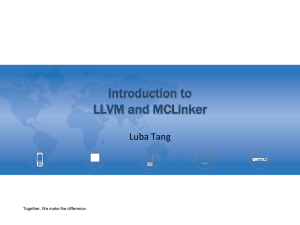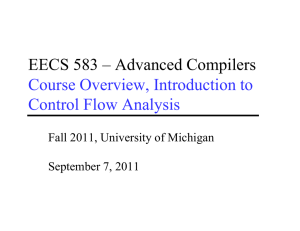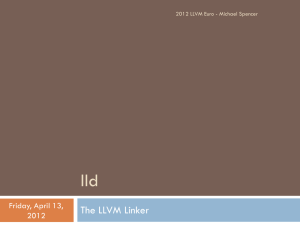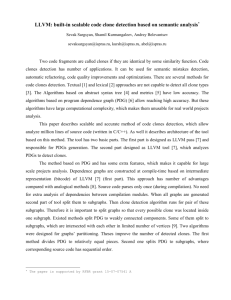Part 1 – LLVM IR Advanced Compiler Construction Labs 2012 Erik Hansson
advertisement
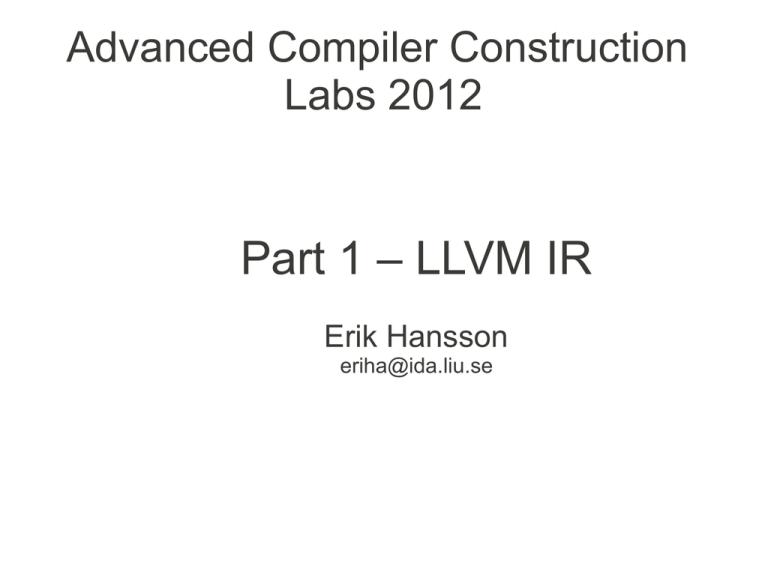
Advanced Compiler Construction
Labs 2012
Part 1 – LLVM IR
Erik Hansson
eriha@ida.liu.se
Overview
●
Low Level Virtual Machine – LLVM
●
●
●
●
●
●
●
http://llvm.org
Modern module based compiler infrastructure
Open Source
Written in C++ (mainly)
Started 2000 at University of Illinois at Urbana–
Champaign by Chris Lattner and Vikram Adve.
In 2005 Lattner got hired by Apple to work with
LLVM.
Popular, check for example www.compilerjobs.com
LLVM get started
●
In Linux
●
Download LLVM 2.6 source
–
●
Unpack it (into LLVM_DIR)
●
Download Clang source
–
●
●
http://llvm.org/releases/
●
Unpack Clang source into LLVM_DIR/tools/clang/
●
In LLVM_DIR run ./configure and ./make -j 2
●
Add LLVM_DIR/Release/bin/ to your PATH (edit .bachrc)
LLVM also works with Mac OS X , Windows (Cygwin) and Solaris.
●
●
http://llvm.org/releases/
Feel free to try it.
If you don't have a Linux machine, we can create an account.
It is OK to try with the latest LLVM version (3.0) as well, but some thing may of
course have changed
LLVM first try
●
Write a small C program.
●
Compile and run
●
●
clang ­o test1 test1.c
●
./test1
●
Just like gcc.
#include
#include<s
<st tddi ioo. .h>
h>
int
main
(
)
int main ( )
{{
ppr ri innt tf f( (" "HHeel ll looLLVM
LLVM++
CLANG!
CLANG!\n"
\n") ); ;
}}
LLVM IR
●
clang test1.c ­S ­emit­llvm ●
This produces test1.s
–
●
Take a look on the output your self!
Convert to bitcode: llvm­as test1.s
–
Produces test1.s.bc
LLVM Passes
●
A pass can do analysis or transformations on the IR.
●
Simple example from the LLVM documentation
–
http://llvm.org/releases/2.6/docs/WritingAnLLVMPass.html
–
http://llvm.org/docs/WritingAnLLVMPass.html
–
Create dir: LLVM_DIR/lib/Transforms/Hello
–
Copy the make file from the page
●
For each function in a program, print out its function name.
●
opt ­load ../../../Debug/lib/Hello.so ­hello < hello.bc > /dev/null
#include "llvm/Pass.h"
#include"llvm/Function.h"
"llvm/Pass.h"
#include
#include"llvm/Support/raw_ostream.h"
"llvm/Function.h"
#include
#include
"llvm/Support/raw_ostream.h"
using namespace
llvm;
using namespace
llvm;
namespace
{
namespace
{
struct Hello : public FunctionPass {
struct Hello : public FunctionPass {
static char ID;
static :char
ID;
Hello()
FunctionPass(&ID)
{}
Hello()
:
FunctionPass(&ID)
{}
virtual bool runOnFunction(Function
&F) {
virtual
bool
runOnFunction(Function
&F)"\n";
{
errs() <<
"Hello:
" << F.getName() <<
errs()
<<
"Hello:
"
<<
F.getName()
<<
"\n";
return false;
} return false;
}; }
}; Hello::ID = 0;
char
char Hello::ID = 0;X("hello", "Hello World Pass");
RegisterPass<Hello>
} RegisterPass<Hello> X("hello", "Hello World Pass");
}
Part 1: Exercise 1
●
Write a simple pass that calculates how many calls
there are to printf() function. Output can for
example be something like:
main:
printf(): 2 calls
foo:
for
for( (i i=2;
=2; i i<4
<4; ;i i++)
++)
{{
ppr ri innt tf f( (" "HHeel ll looLLVM
LLVM++CLANG!
CLANG!\n"
\n") ); ;
}}
printf(): 23 calls
●
It should handle loops, at least if the number of times
the loop body will execute can be determined
statically, and the loops are perfectly nested.
Part 1: Exercise 2a
●
●
Write a pass (or a set of passes) that recognizes the vector init
(initialization of a vector with a constant)
Example:
for
for((i i=0;
=0; i i<<55; ;i i++)
++)
vv[ [i i]=
]=42;
42;
The pass should report:
●
●
Matched computation, operand, size etc.
●
Alternatively replace matched loops by an equivalent function call.
Part 1 Exercise 2b
●
Optional – will give bonus in the exam
●
Write a pass that recognizes dot product calculation:
●
More details in the lab instruction.
Part 2
Back-end
Some Target Code Generation
Exercise by Mattias Eriksson, 2010
Part 2: Adding an instruction to
LLVM
●
●
●
In this assignment you will add a theoretical instruction to
the Sparc target.
Create an add-instruction that takes three operands:
addthree a,b,c,d
This instruction should match the computation d=a+b+c,
where:
●
a,b,c are all integers located in registers,
●
a,b,c are all floats located in registers,
●
a,b are integers in registers, and c is an immediate value.
What is the largest value that c can have in this instruction?
(This value depends on how you made your implementation.)
Part 2: Hints
●
●
●
You can compile your example program to sparc
assembler like this:
clang ­O2 ­S ­emit­llvm foo.c
llvm­as foo.s
llc ­march=sparc ­mcpu=generic ­stats ­asm­verbose foo.s.bc
Look at foo.s.s to see the result.
Declare your variables to be volatile:
volatile int x;
What should be in your report
●
Strategy/Approach for solving the problems.
●
Results of your tests, with comments.
●
Well commented implementation source code.
●
●
●
Test programs, in C and LLVM assembly. Do not forget to
write which built in passes you used and if you used any
optimizations etc. Their invocation order is interesting as well.
Also write which version of LLVM you used and which
platform you used. If you downloaded it via svn please write
the revision number you used.
Nice if you have a (small) discussion part where you can take
up problems you had.
●
Send it the report to me: erik.hansson@liu.se
●
Check deadline on home-page!
Hints: Read, read and try
●
Read a lot – LLVM is large
●
Documentation
–
–
●
http://llvm.org/docs/
http://llvm.org/releases/2.6/docs/index.html
API
–
http://llvm.org/doxygen/
(svn version of LLVM, but still useful)
●
Source files
–
–
●
.h
.cpp
Mailing list
–
Brows and search it, for example:
●
http://dir.gmane.org/gmane.comp.compilers.llvm.devel
